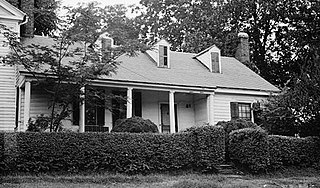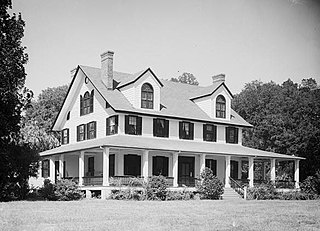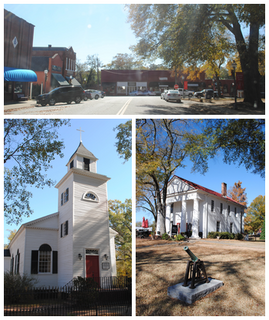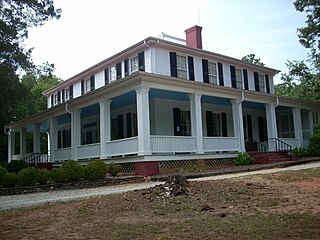
Nicodemus National Historic Site, located in Nicodemus, Kansas, United States, preserves, protects and interprets the only remaining western town established by African Americans during the Reconstruction Period following the American Civil War. The town of Nicodemus is symbolic of the pioneer spirit of African Americans who dared to leave the only region they had been familiar with to seek personal freedom and the opportunity to develop their talents and capabilities. The site was named, at least in part, for a legendary African-American slave featured in abolitionist Henry Clay Work's "Wake, Nicodemus (1864)." It is a mystical story of an old slave died away and buried in a hollow tree who had asked to be awakened on the Day of Jubilee.

West Overton is located approximately 40 miles (64 km) southeast of Pittsburgh, in East Huntingdon Township, Westmoreland County, Pennsylvania, United States. It is on PA 819 between the towns of Mount Pleasant and Scottdale. Its latitude is 40.117N and its longitude is -79.564W.

Fort Hill, also known as the John C. Calhoun Mansion and Library, is a National Historic Landmark on the Clemson University campus in Clemson, South Carolina. The house is significant as the home from 1825-50 of John C. Calhoun, a leading national politician of the period, and is now a museum and library maintained in his memory.

Oconee Station was established in 1792 as a blockhouse on the South Carolina frontier. Troops were removed in 1799. The site also has the Williams Richards House, which was built in the early 19th century as residence and trading post. The site is listed on the National Register of Historic Places in 1971 as Oconee Station and Richards House.

The Old Campus District, University of South Carolina, is a historic district centered on The Horseshoe on the main campus of the University of South Carolina in Columbia, South Carolina. On June 5, 1970, it was listed in the National Register of Historic Places. On April 19, 1996 MTV Unplugged filmed Hootie & the Blowfish's concert on The Horseshoe before the release of their second album Fairweather Johnson.

Borough House Plantation, also known as Borough House, Hillcrest Plantation and Anderson Place, is an historic plantation on South Carolina Highway 261, 0.8 miles (1.3 km) north of its intersection with U.S. Route 76/US Route 378 in Stateburg, in the High Hills of Santee near Sumter, South Carolina. A National Historic Landmark, the plantation is noted as the largest assemblage of high-style pisé structures in the United States. The main house and six buildings on the plantation were built using this technique, beginning in 1821. The plantation is also notable as the home of Confederate Army General Richard H. Anderson.

The Gov. William Aiken House, also known as the Aiken-Rhett House, or the Robinson-Aiken House, is a home built in 1820 at 48 Elizabeth Street in Charleston, South Carolina. The house is the best preserved complex of antebellum domestic structures left in Charleston, South Carolina.

Old Brick Church, which is also known as Ebenezer Associate Reformed Presbyterian (ARP) Church or First Associate Reformed Presbyterian Church is a church built in 1788 about 4 mi (6 km) north of Jenkinsville on SC 213 in Fairfield County, South Carolina. It was named to the National Register of Historic Places on August 19, 1971. It is one of the few 18th-century churches surviving in the South Carolina midlands.

Hillsborough Historic District is a national historic district located at Hillsborough, Orange County, North Carolina. The district encompasses 529 contributing buildings, 9 contributing sites, 13 contributing structures, and 2 contributing objects in the central business district and surrounding residential sections of Hillsborough. The district includes buildings dating to the late-18th and early-20th century and includes notable examples of Federal, Greek Revival, and Italianate style architecture. Located in the district are the separately listed Burwell School, Eagle Lodge, Hazel-Nash House, Heartsease, Montrose, Nash Law Office, Nash-Hooper House, Old Orange County Courthouse, Ruffin-Roulhac House, Sans Souci, and St. Matthew's Episcopal Church and Churchyard. Other notable buildings include Seven Hearths, the Presbyterian Church (1815-1816), Methodist Church (1859-1860), First Baptist Church (1862-1870), Twin Chimneys, and the Berry Brick House.

Downtown Altoona Historic District is a national historic district located at Altoona, Blair County, Pennsylvania. The district includes 240 contributing buildings in the central business district and surrounding residential areas of Altoona. The buildings were primarily built after about 1860 and include residential, civic, social, and religious buildings. Although it does not encompass the entire downtown, it is for the most part the most urban part of Altoona's downtown district. Notable buildings include the Cathedral of the Blessed Sacrament (1920s), First Methodist Episcopal Church, First Presbyterian Church, First Evangelical Lutheran Church (1896-1897), U.S. Post Office (1931-1933), Fraternal Order of Eagles Building, Altoona City Hall, Casanave Building (1890s), Hutchison Block, McCrory's Department Store (1937), and Aaron-Penn Furniture Building. Located in the district are the separately listed Central Trust Company Buildings, Mishler Theatre, and Penn Alto Hotel.

Pee Dee River Rice Planters Historic District is a set of historic rice plantation properties and national historic district located near Georgetown, Georgetown County, South Carolina.

Georgetown Historic District is a national historic district located at Georgetown, Georgetown County, South Carolina. The district encompasses 49 contributing buildings in the central business district of Georgetown. The oldest existing structure in Georgetown is a dwelling which dates from about 1737. There are approximately 28 additional 18th century structures as well as 18 buildings erected during the 19th century prior to the American Civil War. The existing structures—homes, churches, public buildings—are of both historical and architectural significance and are situated on heavily shaded, wide streets. The architecture ranges from the simplicity of early colonial, or Georgian, to the elaborate rice plantation era, such as Classical Revival. Notable buildings include the Georgetown County Courthouse, U.S. Post Office, The Rice Museum, Winyah Indigo Society Hall, Masonic Lodge, Antipedo Baptist Church Cemetery, Prince George Winyah Episcopal Church complex, St. Mary's Catholic Church, Kaminski Building, Mary Man House, Dr. Charles Fyffe / Middleton House, John Cleland / Allston House, Samuel Sampson / Henning-Ward House, Robert Stewart / George Pawley House, Martha Allston Pyatt /John S. Pyatt House, Eleazar Waterman / Withers House, and William Waties / Withers House.

Wicklow Hall Plantation is a historic plantation complex located near Georgetown, Georgetown County, South Carolina. The complex includes the plantation house and several dependencies. The Wicklow Hall Plantation House is a two-story, Greek Revival style clapboard structure on a low brick foundation. The main portion of the structure was probably built between about 1831 and 1840 and enlarged by additions after 1912. Also on the property are a kitchen, corn crib, carriage house, a small house, stable, privy, and a schoolhouse. Wicklow was a major rice plantation during the mid-1800s, and associated with the prominent Lowndes family of South Carolina.

City of Camden Historic District is a national historic district located at Camden, Kershaw County, South Carolina. The district encompasses 48 contributing buildings, 8 contributing sites, 2 contributing structures, and 3 contributing objects in Camden. The district is mostly residential but also include public buildings, a church, and a cemetery. Camden's architecture is classically inspired and includes examples of Federal, Greek Revival, and Classical Revival, in addition to cottage-type, Georgian, Charleston-type with modifications, and mansion-type houses. Several of the city's buildings were designed by architect Robert Mills. Notable buildings include the Kershaw County Courthouse (1826), U.S. Post Office, Camden Opera House and Clock Tower, Camden Powder Magazine, Trinity United Methodist Church, St. Mary's Catholic Church, Gov. Fletcher House, Greenleaf Villa, The First National Bank of Camden, and the separately listed Bethesda Presbyterian Church and Kendall Mill.

Kensington Plantation House is a historic plantation house located near Eastover, Richland County, South Carolina. It was built between 1851 and 1853, by Colonel Richard Singleton, a brother of Angelica Singleton Van Buren, daughter-in-law of President Martin Van Buren. The wood frame dwelling consists of a 2 1/2-story, central section with a Second Empire style copper covered dome, flanked by lower wings with arched colonnades. The front entrance features a porte-cochere with Corinthian order arches and pilasters.

Williams Place is a historic home and farm complex located near Glenn Springs, Spartanburg County, South Carolina. It was developed between about 1839 and 1850, and includes 10 contributing buildings, 1 contributing site, and 2 contributing structures. The majority of the buildings are of log construction and include a small house, a large house, a kitchen, a smokehouse, a smithy, two corn cribs, a ruined house, and barn / stable. Frame buildings and structures include a privy and a barn. Also on the property are a well and an earthen dam.

South Street–South Church Street Historic District is a national historic district located at Union, Union County, South Carolina. The district encompasses 78 contributing buildings in a primarily residential section of Union. The houses were built between about 1850 to about 1930, with the majority dating from about 1850 to about 1915. The district includes many large-frame Queen Anne inspired houses built about 1880-1910. Also in the district are Neo-Classical, Gothic Revival, Colonial Revival, Tudor Revival, American Foursquare, and Bungalow style dwellings. The district includes the first Carnegie Library established in South Carolina.

Winthrop College Historic District is a national historic district located on the campus of Winthrop University at Rock Hill, South Carolina. It encompasses 17 contributing buildings and 1 contributing structure constructed between 1894 and 1943. Architectural styles represented include Gothic Revival, Richardsonian Romanesque, Classical Revival, and Colonial Revival. Notable buildings include the separately listed Tillman Hall and Withers Building, as well as Alumni House, Phelps Dormitory, Thurmond Building, Byrnes Auditorium, Johnson Hall, and the President's Residence.




























